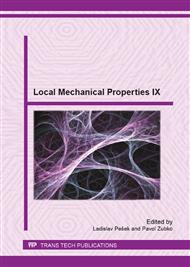p.108
p.112
p.116
p.120
p.125
p.129
p.133
p.137
p.141
Comparison of the Natural Ageing Behaviour of EN AW 6082 and Lead Free EN AW 6023 Aluminium Alloys
Abstract:
The effect of solution annealing temperature (550 and 570°C) on the Vickers microhardness of the quenched and naturally aged states of EN AW 6082 and lead free aluminium alloy was investigated. The different chemical composition of analysed alloys did not affect the alloys microhardness after quenching. The total strengthening of both alloys was similar due to the same conjunction of the individual strengthening mechanism of alloys matrix after quenching. The microhardness of EN AW 6082 increased with ageing time increasing according to logarithmic dependence because the increment in alloy microhardness decreased with the increase in ageing time. On the contrary, microhardness of lead-free EN AW 6023 did not increase markedly either after 500 hours natural ageing. This alloy have very slow rate of natural ageing, probably due to suppressed diffusion of alloying elements and clusters and/or GP-zone formation in supersaturated solid solution.
Info:
Periodical:
Pages:
125-128
Citation:
Online since:
September 2013
Authors:
Keywords:
Price:
Сopyright:
© 2014 Trans Tech Publications Ltd. All Rights Reserved
Share:
Citation:


